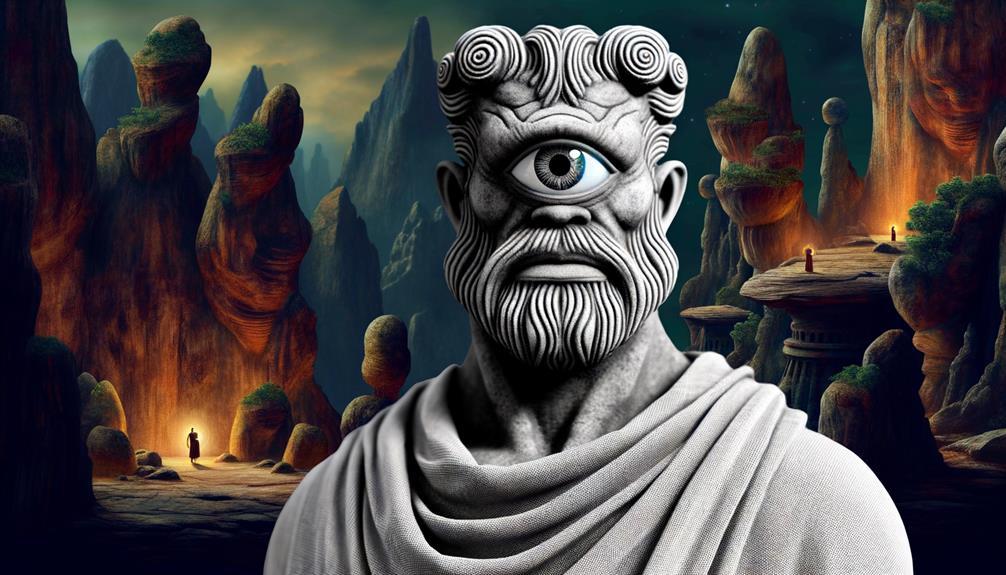You might think having just one eye is a serious setback, but the Cyclops of Greek mythology didn't see it that way. These one-eyed giants had an impressive knack for forging thunderbolts and, um, they had a bit of a taste for humans from time to time. If we're talking about manners and social graces, well, let's just say they were a bit lacking. But it's hard to deny that these characters, with their deep roots in Greek literature, are intriguing to say the least.
Polyphemus, the baddest of the bunch, made quite a name for himself in Homer's Odyssey. His less than friendly reception for Odysseus and his crew set him apart as a classic villain. But there's more to the Cyclops than just their, well, singular eye. So come along, dust off that old Greek dictionary, and let's see what these mythical creatures have to tell us about our own nature and the world of our ancestors. Hold on tight, this is going to be a wild, one-eyed adventure.
Origins of the Cyclops Myth

Let's take a closer look at the roots of the Cyclops myth. These one-eyed giants are a fundamental part of Greek lore and literature, notorious for their taste for human flesh and their simple, countryside way of life. With just one eye, the Cyclopes have etched a significant mark in the annals of ancient Greek mythology.
One of the most standout Cyclopes is Polyphemus, who is best known for his brush with Odysseus in the Greek epic, The Odyssey. True to form, Polyphemus tried to feast on Odysseus and his men. But thanks to Odysseus's quick thinking and his plan to blind Polyphemus's single eye, they were able to make their getaway.
But the Cyclopes weren't just characters in grand stories; they were also known for their divine abilities. According to Hesiod, three Cyclopes, who were the offspring of Uranus and Gaea, were responsible for crafting Zeus' thunderbolts.
In the field of archaeology, the term 'Cyclopean' is used to denote walls made of rough-hewn stones, suggesting that such ancient Greek structures were the work of these mythical one-eyed giants. Cities that have Cyclopean walls are thought to have been erected by the Cyclopes, which further intertwines their legend with the threads of ancient history. The Cyclops myth still holds our interest, echoing in literature, archaeology, and mainstream culture.
The Cyclops in Greek Literature
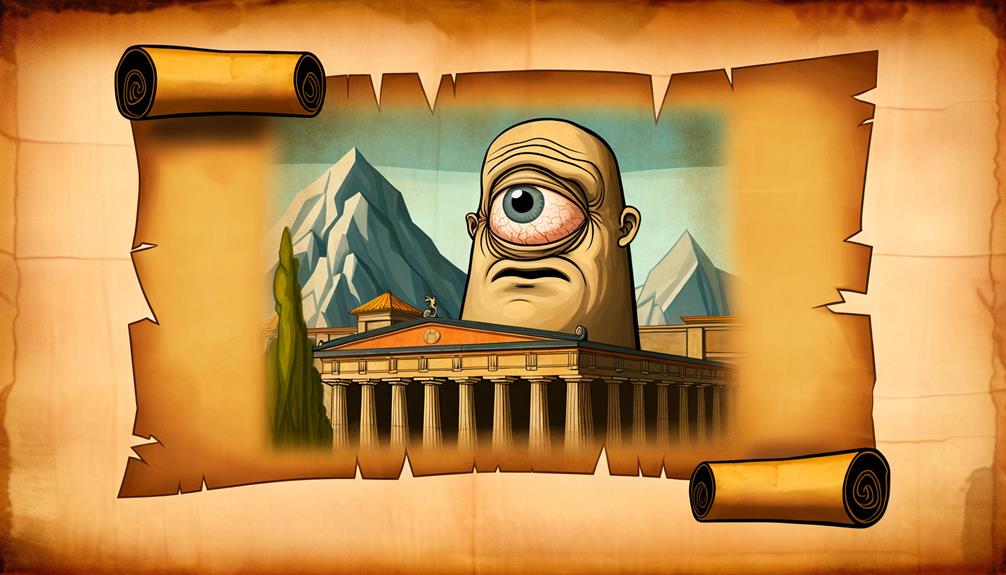
Diving into the intriguing world of Greek literature, we encounter the Cyclops, fascinating one-eyed giants known for their blend of raw power and divine might.
One of these Cyclops, Polyphemus, takes center stage in Homer's epic, the Odyssey. In this tale, we see the Greek hero Odysseus outwit the Cyclops Polyphemus, blinding the giant to make his escape. Not only does this story highlight the brutal nature of the Cyclops, but it also brings to the forefront the sharp intelligence of Odysseus.
Greek literature also tells us about the sons of Uranus – a trio of Cyclops known for their divine craftsmanship. However, their story takes a tragic turn when they're slain by Apollo, Zeus's son, due to a prophecy.
To help you remember, we've made a quick summary of the roles of Cyclops in Greek literature:
| Story | Cyclops | Role |
|---|---|---|
| The Odyssey | Polyphemus | Villain |
| Hesiod's Theogony | Sons of Uranus | Artisans with divine power and allies of Zeus |
| Homer's Iliad | Cyclopean walls | Builders |
This simple table provides an easy reminder of how Cyclops are portrayed in Greek literature – from antagonists to divine craftsmen and builders.
The Tale of Odysseus and Polyphemus
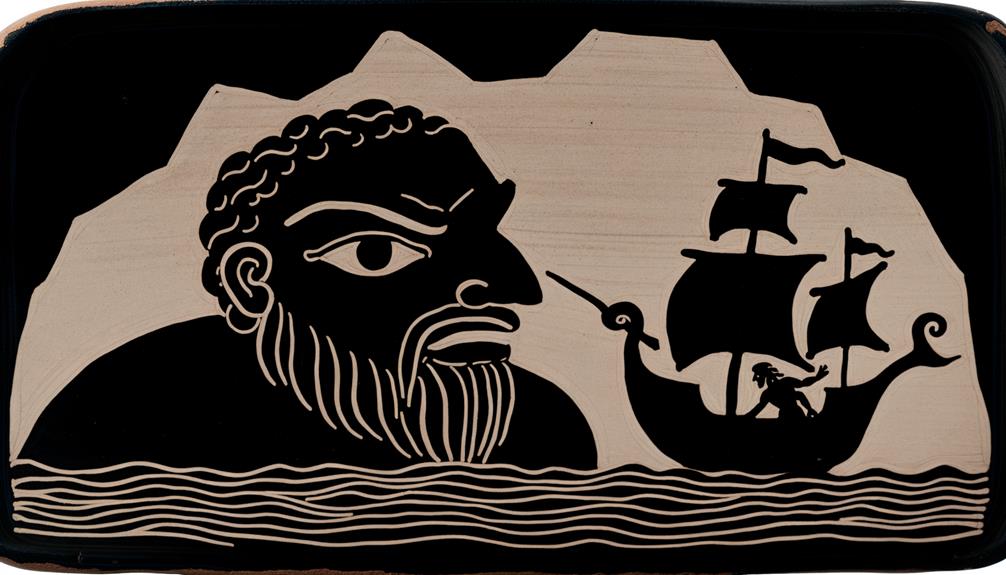
In the gripping narrative of Odysseus' journey home after the Trojan War, he encounters the fearsome one-eyed giant, Polyphemus. This meeting ramps up the danger and excitement in his adventure. The tale of Polyphemus and Odysseus is a gripping narrative, teeming with anticipation and sharp thinking.
In the story, we meet:
- Polyphemus, the terrifying, human-devouring giant, and son of Poseidon, who traps Odysseus and his crew in his cave.
- The resourceful hero, Odysseus, who thinks up a strategy to break free from the giant's grip.
- The incident in which Polyphemus is blinded – Odysseus uses a pointed stake to blind the giant, creating an opportunity for him and his crew to flee.
- The instance when Odysseus reveals his name to Polyphemus, paving the way for future problems.
- The aftermath, where a sightless Polyphemus seeks revenge on Odysseus for his deeds.
This meeting between Odysseus and Polyphemus is a significant episode in Odysseus' journey, showcasing his sharp wit and courage when faced with extreme peril. This tale remains one of the standout sections of The Odyssey, evidencing the lasting allure of this ancient hero's story.
Artistic Depictions of Cyclopes
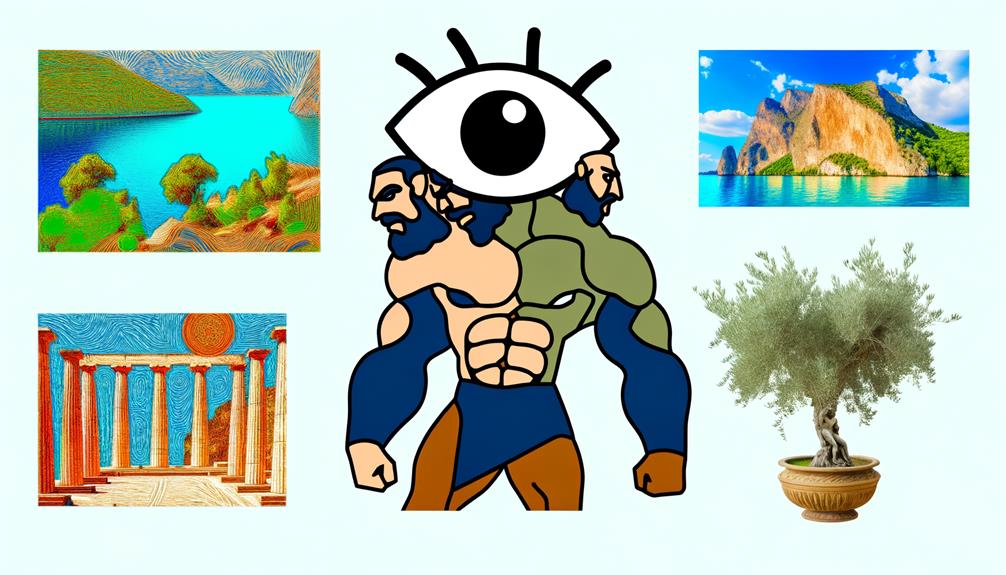
Think about the story of Odysseus and Polyphemus. This tale gives us an intense image of the terrifying Cyclops. But that image becomes even more potent when you see it in artworks. It's in these pieces that the one-eyed giants are brought to life, their power and complexity given shape and form. Greek and Roman artists loved to draw and paint these Cyclopes. Their artworks often depicted them as strong, imposing figures with a single, intense eye.
Remember when Odysseus and his crew were on their way back from the Trojan war? They ran into these scary creatures. The Capitoline Museum has a painting that tells the story of this dangerous journey. It shows just how much fear and respect the Cyclopes inspired. There's also a fantastic fresco dating back to the AD era. It was discovered in the villa of Tiberius at Sperlonga, and it shows the intense scene of the Cyclops being blinded.
There are even more of these artworks in the Archaeological Museum in Athens. Just looking at them, you can almost imagine the Cyclops' roar and the heroes' shock as they run into these creatures. The artworks give us a visual interpretation of the myth. They also show us how much these mythical creatures have influenced culture over time. So, you see, they're not just paintings or sculptures – they're windows into the past.
Possible Historical Inspirations
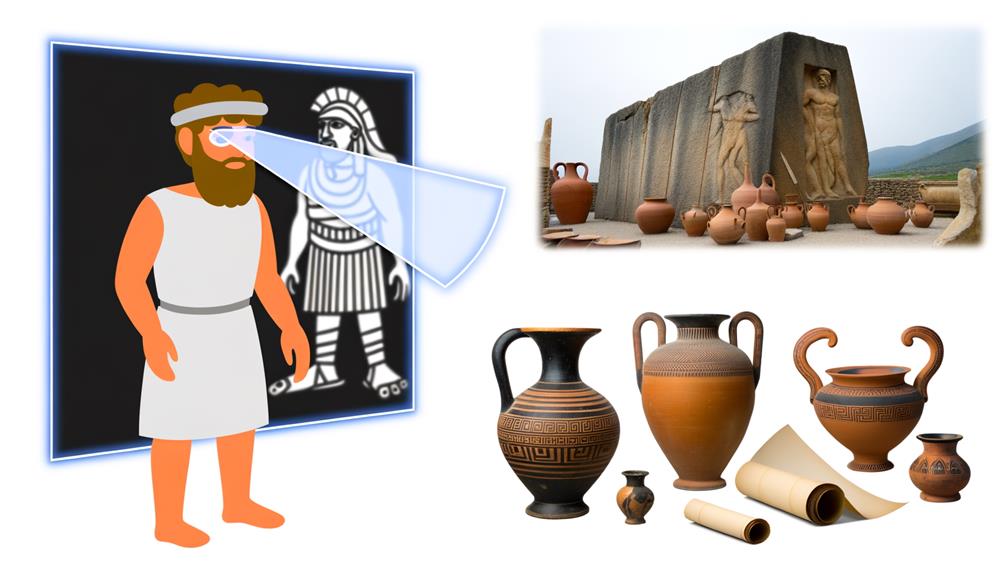
It's always intriguing to uncover the real-life foundations that might have given rise to myths and legends. Let's consider the Cyclops, the notorious one-eyed giant from Greek mythology. A few historical breadcrumbs might shed light on how this mythical creature came into being.
Perhaps ancient Greeks stumbled upon mammoth skulls, mistaking their large central cavity for a singular eye socket of a Cyclops. Similarly, finding elephant skulls with their prominent central cavities might have strengthened this one-eyed giant narrative.
The connection of the Homeric Cyclopes with the volcanic activity of Mount Etna could be a story inspired by witnessing the strength of geological formations.
Then there's the imposing Cyclopean walls of Mycenae and Tiryns, structures that showcased superior architectural skill. This might have fuelled stories of Cyclopes being master builders.
And finally, the portrayal of Cyclopes as crude shepherds might be linked to Greeks' interactions with distant pastoral societies.
These real-life elements add a certain depth to the mythical tale, much like the satyrs that brought humour to a BC play written by Euripides. Whether it's Hesiod's Cyclopes or the depiction in the painting 'Odysseus: Guido Reni', these elements infuse a touch of realism to the myth. Even writers who came later, crafting narratives in the villa of Tiberius, built upon these elements.
Frequently Asked Questions
What Is the Story of the One-Eyed Cyclops?
Hey, have you ever heard about the story of the one-eyed giant? This monstrous being is a popular figure in Greek folklore, famously known as a Cyclops. The most notorious among them is a guy named Polyphemus. He almost gobbled up Odysseus and his team, but they were clever enough to trick him and left him sightless. Interesting, isn't it?
Who Is the One-Eyed Giant in Mythology?
So, you're curious about the one-eyed giant in mythology? Well, let me tell you, it's a fascinating story from Greek lore! The creature you're thinking of is a Cyclops. These beings are notorious for their massive power and impressive skills in crafting. But what really sets them apart is their single eye. You might have heard of the most renowned Cyclops, Polyphemus, from Homer's epic tale, the Odyssey. Now that's a character who's left a mark on the world of mythology!
What Is the Myth Behind the Cyclops?
Isn't the myth of the Cyclops utterly intriguing? Just think about it – these monstrous beings with a single eye, especially the renowned Polyphemus from Homer's Odyssey, were celebrated for their might. But there's more to them – they were skilled artisans as well. Believe it or not, they were supposed to have fashioned Zeus's thunderbolts, which puts an interesting spin on their otherwise frightful persona.
Who Is the Giant With One Eye in Greek Mythology?
So, you're curious about the one-eyed giant from Greek mythology? Well, let me fill you in – this creature is called a Cyclops. These guys are pretty infamous in the stories, often shown as living in the countryside and having a rather disturbing diet – they eat humans! One of the most famous Cyclops is a guy named Polyphemus, who makes an appearance in the Odyssey, a classic work by the poet Homer.

